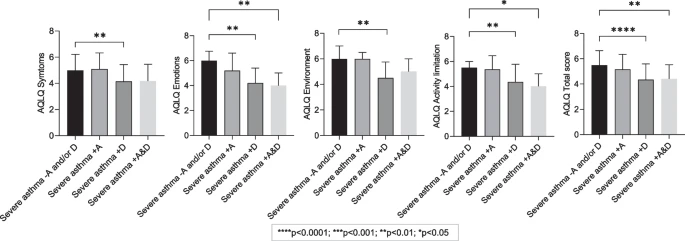Research – Open Access
Michelle A. Stubbs, Vanessa L. Clark, Peter G. Gibson, Janelle Yorke & Vanessa M. McDonald

Respiratory Research volume 23, Article number: 341 (2022)
Abstract
Background
Anxiety and depression are comorbidities of severe asthma. However, clinical characteristics associated with coexisting severe asthma and anxiety/depression are poorly understood. The study objective is to determine clinical characteristics associated with anxiety and depressive symptoms in severe asthma.
Methods
Severe asthma participants (N = 140) underwent a multidimensional assessment. Categorization of symptoms of anxiety and depression were based on HADS scale sub-scores and divided into four groups (< 8 on both subscales; ≥ 8 on one subscale; ≥ 8 on both subscales). Clinical characteristics were compared between subgroups. Multivariate logistic regression determined associations of clinical characteristics and anxiety and/or depressive symptoms in people with severe asthma.
Results

Participants were (mean ± SD) 59.3 ± 14.7 years old, and 62% female. There were 74 (53%) severe asthma participants without symptoms of anxiety/depression, 11 (7%) with symptoms of anxiety, 37 (26%) with symptoms of depression and 18 (13%) with symptoms of anxiety and depression. Quality of life impairment was greater in participants with symptoms of depression (4.4 ± 1.2) and combined symptoms of anxiety and depression (4.4 ± 1.1). Asthma control was worse in those with symptoms of depression (2.9 ± 1.1) and combined anxiety and depression (2.6 ± 1.0). In multivariate models, dysfunctional breathing was associated with symptoms of anxiety (OR = 1.24 [1.01, 1.53]). Dyspnoea was associated with symptoms of depression (OR = 1.90 [1.10, 3.25]). Dysfunctional breathing (OR 1.16 [1.04, 1.23]) and obesity (OR 1.17 [1.00, 1.35]) were associated with combined symptoms of anxiety and depression.
Conclusion
People with severe asthma and anxiety and/or depressive symptoms have poorer QoL and asthma control. Dyspnoea, dysfunctional breathing and obesity are associated with these symptoms. These key clinical characteristics should be targeted in severe asthma management.
